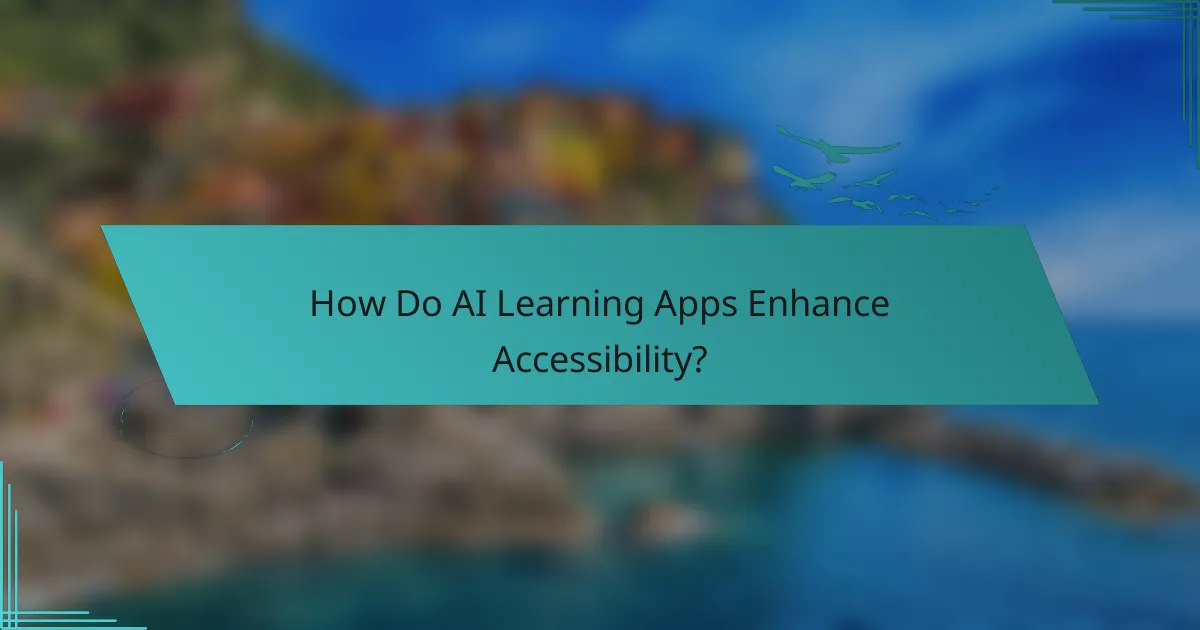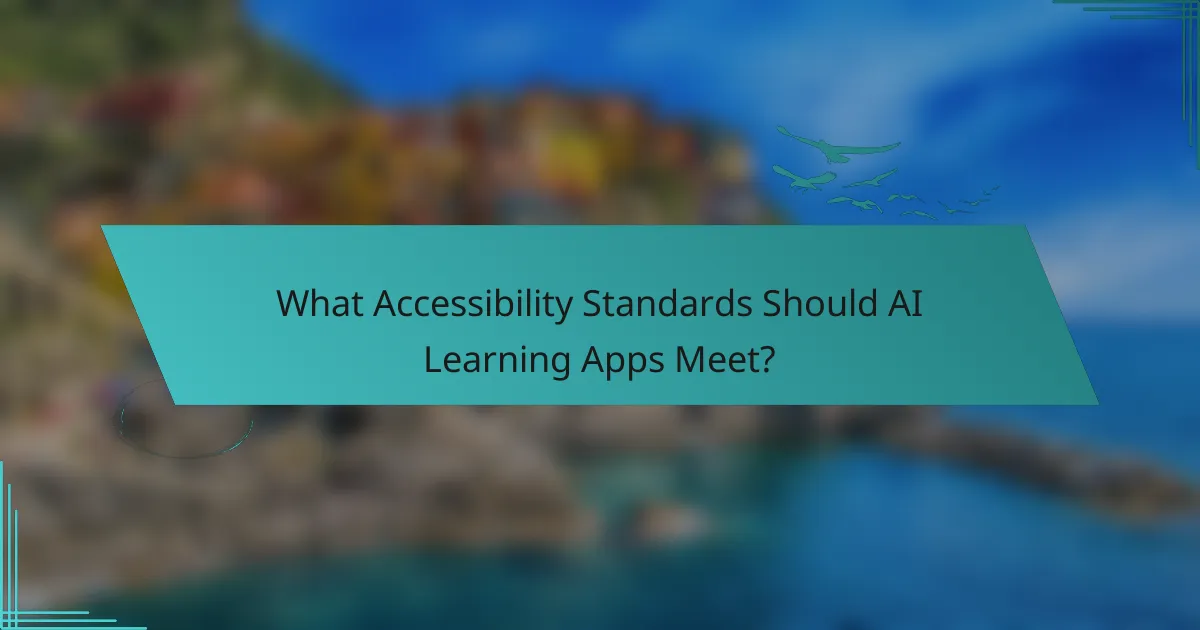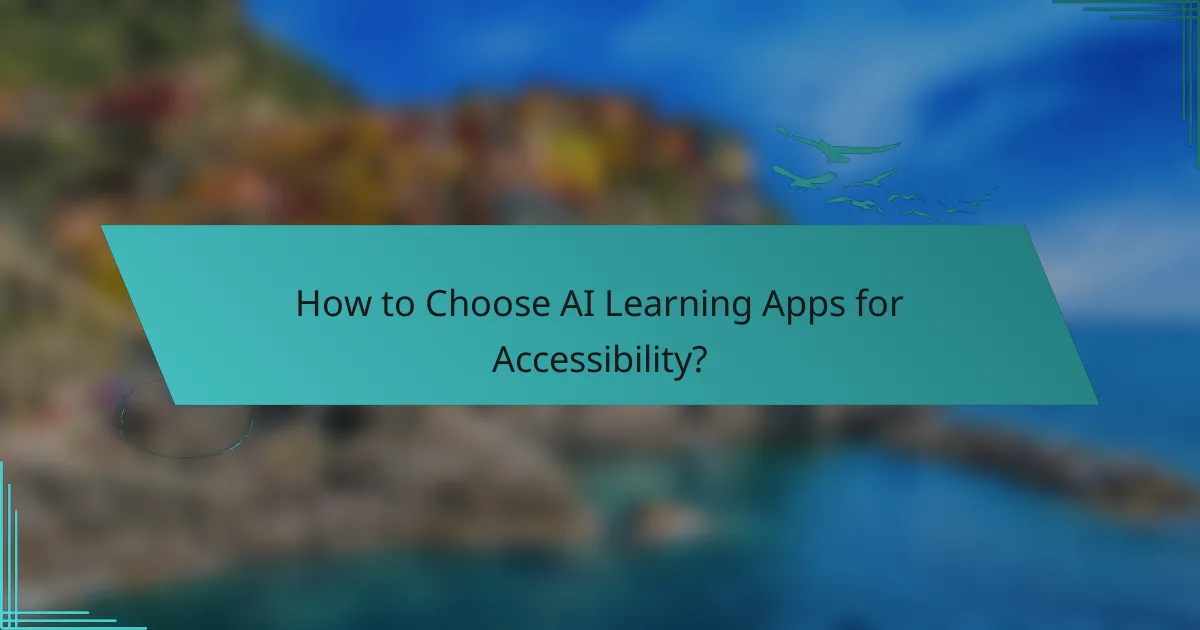Choosing the right AI learning apps is crucial for fostering an inclusive educational environment that meets diverse learning needs. These tools are designed with accessibility in mind, incorporating features like text-to-speech and customizable interfaces to support users with disabilities. Ensuring that these apps adhere to established accessibility standards, such as WCAG and ADA, is essential for maximizing their effectiveness and usability.

What Are the Best AI Learning Apps for Accessibility?
The best AI learning apps for accessibility are designed to support diverse learning needs, ensuring that all users can engage with educational content effectively. Key features often include text-to-speech, speech recognition, and customizable interfaces that cater to various disabilities.
Microsoft Learning Tools
Microsoft Learning Tools enhance accessibility by providing features like Immersive Reader, which offers text-to-speech, line focus, and translation capabilities. These tools are integrated into Microsoft Office applications, making them easily accessible for users familiar with the Microsoft ecosystem.
Consider using Microsoft Learning Tools if you require support for reading comprehension or language translation. They are particularly beneficial for students with dyslexia or those learning a new language.
Google Classroom
Google Classroom supports accessibility through its integration with various assistive technologies, including screen readers and voice typing. The platform allows teachers to create accessible assignments and materials that can be easily shared with students.
When using Google Classroom, ensure that all materials are compatible with accessibility features. This includes using clear fonts, providing alternative text for images, and structuring content for easy navigation.
Read&Write
Read&Write is an assistive technology tool that offers features such as text-to-speech, highlighting, and dictionary support. It is designed to help users with reading and writing difficulties, making it a valuable resource in educational settings.
Utilize Read&Write if you need support with comprehension or writing tasks. Its browser extension allows for seamless integration with various online platforms, enhancing accessibility across different learning environments.
Speechify
Speechify is a text-to-speech app that converts written content into audio, making it easier for users to consume information. It supports multiple languages and offers adjustable reading speeds, catering to individual preferences.
This app is ideal for auditory learners or those with visual impairments. Speechify can be used on various devices, allowing users to listen to documents, articles, and even web pages on the go.
Kurzweil 3000
Kurzweil 3000 is a comprehensive learning tool designed for individuals with learning disabilities. It provides features such as text-to-speech, study tools, and customizable reading environments to enhance learning experiences.
Consider Kurzweil 3000 if you require a robust solution for reading and comprehension support. Its extensive features make it suitable for both classroom and individual use, helping to create an inclusive learning atmosphere.

How Do AI Learning Apps Enhance Accessibility?
AI learning apps enhance accessibility by incorporating features that cater to diverse learning needs and preferences. These tools help users with disabilities engage more effectively with educational content, ensuring a more inclusive learning environment.
Text-to-Speech Features
Text-to-speech (TTS) features convert written text into spoken words, making content accessible for users with visual impairments or reading difficulties. This functionality allows learners to listen to lessons, instructions, and materials, which can significantly improve comprehension and retention.
When selecting an AI learning app, look for TTS options that support multiple languages and have adjustable speech rates. Some apps even allow users to choose different voice types, enhancing personalization and engagement.
Customizable Learning Interfaces
Customizable learning interfaces enable users to tailor their experience according to their individual needs. This can include adjusting font sizes, color contrasts, and layout designs, which are crucial for users with visual impairments or learning disabilities like dyslexia.
When evaluating an app, check for options that allow users to modify the interface easily. Features such as dark mode, text spacing adjustments, and the ability to save personal settings can greatly enhance usability and comfort.
Real-Time Feedback Mechanisms
Real-time feedback mechanisms provide immediate responses to user actions, helping learners understand their progress and areas needing improvement. This instant feedback is particularly beneficial for users with cognitive disabilities, as it reinforces learning through timely corrections and encouragement.
Choose apps that offer varied feedback types, such as visual cues, audio prompts, or gamified rewards. These elements can motivate users and create a more engaging learning experience, fostering a sense of achievement and encouraging persistence.

What Accessibility Standards Should AI Learning Apps Meet?
AI learning apps should meet established accessibility standards to ensure they are usable by individuals with disabilities. Key standards include the Web Content Accessibility Guidelines (WCAG), Section 508 of the Rehabilitation Act, and the Americans with Disabilities Act (ADA) requirements.
WCAG Compliance
WCAG compliance focuses on making web content more accessible to people with disabilities. The guidelines are organized around four principles: perceivable, operable, understandable, and robust. Developers should aim for at least Level AA compliance, which includes providing text alternatives for non-text content and ensuring that all functionality is available from a keyboard.
To assess compliance, consider using automated tools alongside manual testing. Common pitfalls include neglecting color contrast and failing to provide captions for multimedia content. Regular audits can help maintain compliance as updates are made to the app.
Section 508 Standards
Section 508 standards require federal agencies to make their electronic and information technology accessible to people with disabilities. This includes software applications and websites, ensuring they provide equal access to information and functionality. AI learning apps targeting government contracts must adhere to these standards.
Key considerations include ensuring compatibility with assistive technologies and providing accessible documentation. Developers should conduct user testing with individuals who have disabilities to identify potential barriers. Non-compliance can lead to legal repercussions and loss of contracts.
ADA Requirements
The Americans with Disabilities Act (ADA) mandates that public accommodations, including educational tools, must be accessible to individuals with disabilities. This includes AI learning apps, which should provide equal opportunities for participation and benefit. Failure to comply can result in lawsuits and significant financial penalties.
To meet ADA requirements, ensure that your app is usable by people with various disabilities, including visual, auditory, and cognitive impairments. Implementing features such as screen reader compatibility and easy navigation can enhance accessibility. Regular feedback from users with disabilities can guide necessary improvements.

How to Choose AI Learning Apps for Accessibility?
Choosing AI learning apps that support accessibility involves evaluating their user-friendliness for individuals with diverse needs. Focus on features that enhance usability, such as screen reader compatibility, customizable interfaces, and support for various input methods.
Evaluate User Reviews
User reviews provide valuable insights into the accessibility of AI learning apps. Look for feedback from users with disabilities to understand their experiences and any challenges they faced. Pay attention to comments regarding ease of navigation, responsiveness of customer support, and overall satisfaction.
Consider aggregating ratings from multiple platforms to get a balanced view. A high average rating is a positive sign, but specific comments about accessibility features are crucial for informed decision-making.
Check Accessibility Features
Assess the accessibility features of each app before making a choice. Key elements to look for include compatibility with screen readers, adjustable text sizes, color contrast options, and keyboard navigation support. These features ensure that users with visual or motor impairments can effectively engage with the content.
Additionally, verify if the app complies with established accessibility standards, such as the Web Content Accessibility Guidelines (WCAG). This compliance indicates a commitment to inclusivity and usability.
Compare Pricing Models
Pricing models for AI learning apps can vary significantly, impacting accessibility options. Some apps offer free versions with limited features, while others may charge monthly or annual fees. Evaluate what features are included at each price point, especially those related to accessibility.
Consider whether the app provides a free trial or a money-back guarantee, allowing you to test its accessibility features without financial commitment. This approach helps ensure that you choose a tool that meets your needs without overspending.

What Are the Challenges in Implementing AI Learning Apps?
Implementing AI learning apps presents several challenges, primarily related to technical limitations and user training needs. These obstacles can hinder the effective integration of AI tools into educational environments, impacting accessibility and overall user experience.
Technical Limitations
Technical limitations often arise from the complexity of AI algorithms and the need for robust infrastructure. Many educational institutions may lack the necessary hardware or software capabilities, which can lead to slow performance or system crashes during usage.
Additionally, compatibility issues with existing learning management systems (LMS) can pose significant barriers. Ensuring that AI applications work seamlessly with current platforms is crucial for successful implementation.
User Training Needs
User training is essential for maximizing the benefits of AI learning apps. Educators and students must understand how to effectively use these tools to enhance learning outcomes. Without proper training, users may struggle to navigate the features or utilize the AI capabilities fully.
Institutions should consider providing comprehensive training sessions and ongoing support to address these needs. This can include workshops, tutorials, and easily accessible resources to help users become proficient with the technology.
